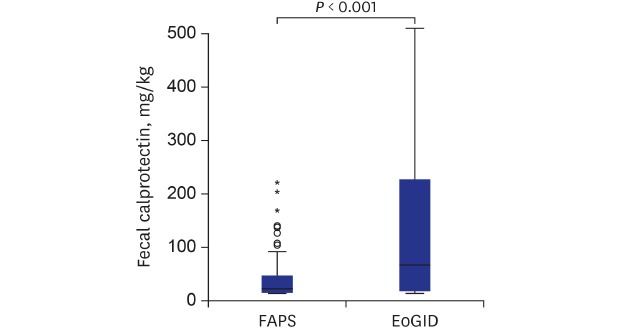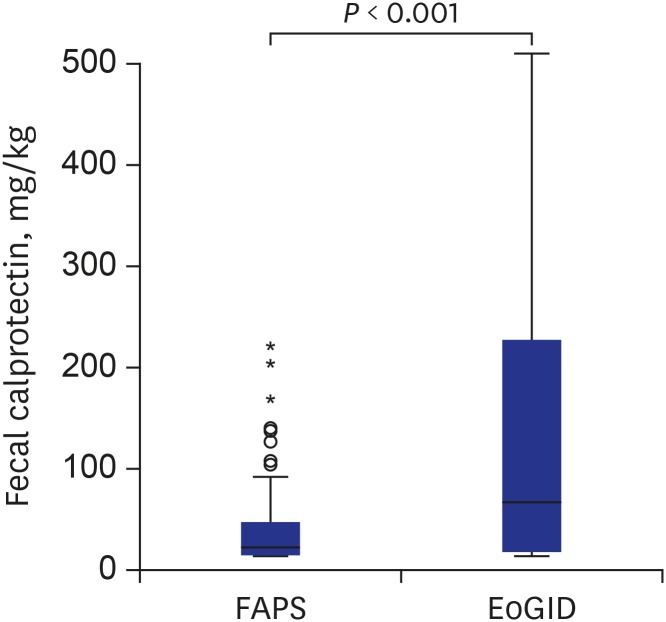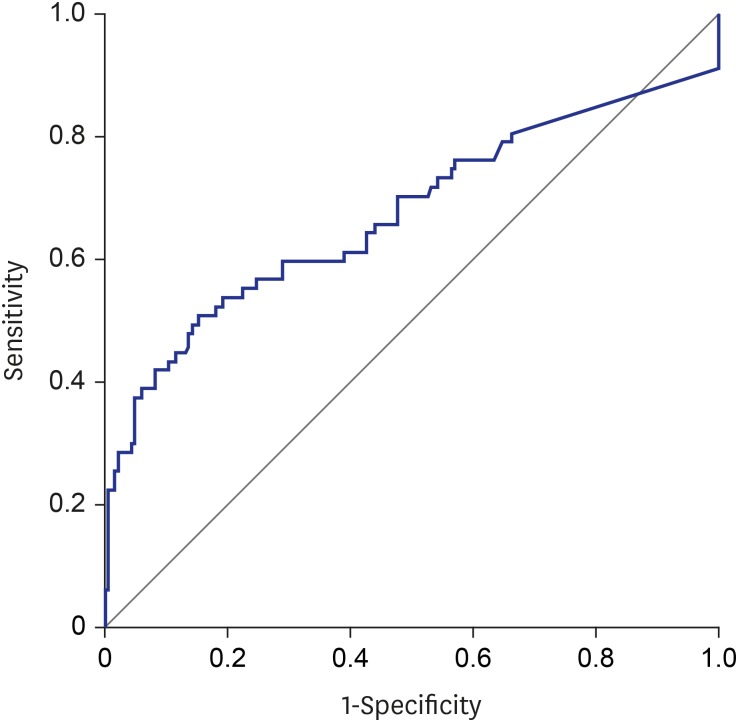1. Hogan SP, Rothenberg ME. Review article: the eosinophil as a therapeutic target in gastrointestinal disease. Aliment Pharmacol Ther. 2004; 20(11-12):1231–1240. PMID:
15606385.

2. Ko HM, Morotti RA, Yershov O, Chehade M. Eosinophilic gastritis in children: clinicopathological correlation, disease course, and response to therapy. Am J Gastroenterol. 2014; 109(8):1277–1285. PMID:
24957155.

3. Spergel JM, Book WM, Mays E, Song L, Shah SS, Talley NJ, et al. Variation in prevalence, diagnostic criteria, and initial management options for eosinophilic gastrointestinal diseases in the United States. J Pediatr Gastroenterol Nutr. 2011; 52(3):300–306. PMID:
21057327.

4. Uppal V, Kreiger P, Kutsch E. Eosinophilic gastroenteritis and colitis: a comprehensive review. Clin Rev Allergy Immunol. 2016; 50(2):175–188. PMID:
26054822.

5. Jensen ET, Martin CF, Kappelman MD, Dellon ES. Prevalence of eosinophilic gastritis, gastroenteritis, and colitis: estimates from a national administrative database. J Pediatr Gastroenterol Nutr. 2016; 62(1):36–42. PMID:
25988554.
6. Kinoshita Y, Ishimura N, Oshima N, Ishihara S. Systematic review: eosinophilic esophagitis in Asian countries. World J Gastroenterol. 2015; 21(27):8433–8440. PMID:
26217096.

7. Choi BS, Hong SJ, Park SH, Kim HM, Choe BH. Differences in features and course of mucosal type eosinophilic gastroenteritis between Korean infants and children. J Korean Med Sci. 2015; 30(8):1129–1135. PMID:
26240491.

8. Kwon JY, Huh JS, Je BK, Hong KD, Lee JH. Eosinophilic gastrointestinal disorder presenting as intractable vomiting and ascites in a young girl. Pediatr Gastroenterol Hepatol Nutr. 2017; 20(3):198–203. PMID:
29026737.

9. Rothenberg ME. Eosinophilic gastrointestinal disorders (EGID). J Allergy Clin Immunol. 2004; 113(1):11–28. PMID:
14713902.

10. Konikoff MR, Denson LA. Role of fecal calprotectin as a biomarker of intestinal inflammation in inflammatory bowel disease. Inflamm Bowel Dis. 2006; 12(6):524–534. PMID:
16775498.

11. Montalto M, Gallo A, Santoro L, D'Onofrio F, Landolfi R, Gasbarrini A. Role of fecal calprotectin in gastrointestinal disorders. Eur Rev Med Pharmacol Sci. 2013; 17(12):1569–1582. PMID:
23832721.
12. Vermeire S, Van Assche G, Rutgeerts P. Laboratory markers in IBD: useful, magic, or unnecessary toys? Gut. 2006; 55(3):426–431. PMID:
16474109.

13. Olafsdottir I, Nemeth A, Lörinc E, Toth E, Agardh D. Value of fecal calprotectin as a biomarker for juvenile polyps in children investigated with colonoscopy. J Pediatr Gastroenterol Nutr. 2016; 62(1):43–46. PMID:
26147630.

14. Mahjoub FE, Zahedi N, Ashjai B, Ashtiani MT, Farahmand F, Monajemzadeh M, et al. Role of fecal calprotectin in differentiating between Hirschsprung's disease and functional constipation. Korean J Gastroenterol. 2013; 62(5):288–291. PMID:
24262594.

15. Degraeuwe PL, Beld MP, Ashorn M, Canani RB, Day AS, Diamanti A, et al. Faecal calprotectin in suspected paediatric inflammatory bowel disease. J Pediatr Gastroenterol Nutr. 2015; 60(3):339–346. PMID:
25373864.

16. Trillo Belizón C, Ortega Páez E, Medina Claros AF, Rodríguez Sánchez I, Reina González A, Vera Medialdea R, et al. Faecal calprotectin as an aid to the diagnosis of non-IgE mediated cow's milk protein allergy. An Pediatr (Barc). 2016; 84(6):318–323. PMID:
26342278.

17. Biskou O, Gardner-Medwin J, Mackinder M, Bertz M, Clark C, Svolos V, et al. Faecal calprotectin in treated and untreated children with coeliac disease and juvenile idiopathic arthritis. J Pediatr Gastroenterol Nutr. 2016; 63(5):e112–e115. PMID:
27540707.

18. Olafsdottir I, Nemeth A, Lörinc E, Toth E, Agardh D. Value of fecal calprotectin as a biomarker for juvenile polyps in children investigated with colonoscopy. J Pediatr Gastroenterol Nutr. 2016; 62(1):43–46. PMID:
26147630.

19. Hyams JS, Di Lorenzo C, Saps M, Shulman RJ, Staiano A, van Tilburg M. Functional disorders: children and Adolescents. Gastroenterology. 2016; 150:1456–1468.
20. Alhmoud T, Hanson JA, Parasher G. Eosinophilic gastroenteritis: an underdiagnosed condition. Dig Dis Sci. 2016; 61(9):2585–2592. PMID:
27234270.

21. Uppal V, Kreiger P, Kutsch E. Eosinophilic gastroenteritis and colitis: a comprehensive review. Clin Rev Allergy Immunol. 2016; 50(2):175–188. PMID:
26054822.

22. Chen MJ, Chu CH, Lin SC, Shih SC, Wang TE. Eosinophilic gastroenteritis: clinical experience with 15 patients. World J Gastroenterol. 2003; 9(12):2813–2816. PMID:
14669340.

23. Lee EH, Yang HR, Lee HS. Quantitative analysis of distribution of the gastrointestinal tract eosinophils in childhood functional abdominal pain disorders. J Neurogastroenterol Motil. 2018; 24(4):614–627. PMID:
30180307.

24. Spergel JM, Shuker M. Nutritional management of eosinophilic esophagitis. Gastrointest Endosc Clin N Am. 2008; 18(1):179–194. PMID:
18061111.

25. Shaheen NJ, Mukkada V, Eichinger CS, Schofield H, Todorova L, Falk GW. Natural history of eosinophilic esophagitis: a systematic review of epidemiology and disease course. Dis Esophagus. 2018; 31(8):doy015.

26. Desreumaux P, Bloget F, Seguy D, Capron M, Cortot A, Colombel JF, et al. Interleukin 3, granulocyte-macrophage colony-stimulating factor, and interleukin 5 in eosinophilic gastroenteritis. Gastroenterology. 1996; 110(3):768–774. PMID:
8608886.

27. Koutri E, Papadopoulou A. Eosinophilic gastrointestinal diseases in childhood. Ann Nutr Metab. 2018; 73(Suppl 4):18–28. PMID:
30783041.






 PDF
PDF Citation
Citation Print
Print






 XML Download
XML Download